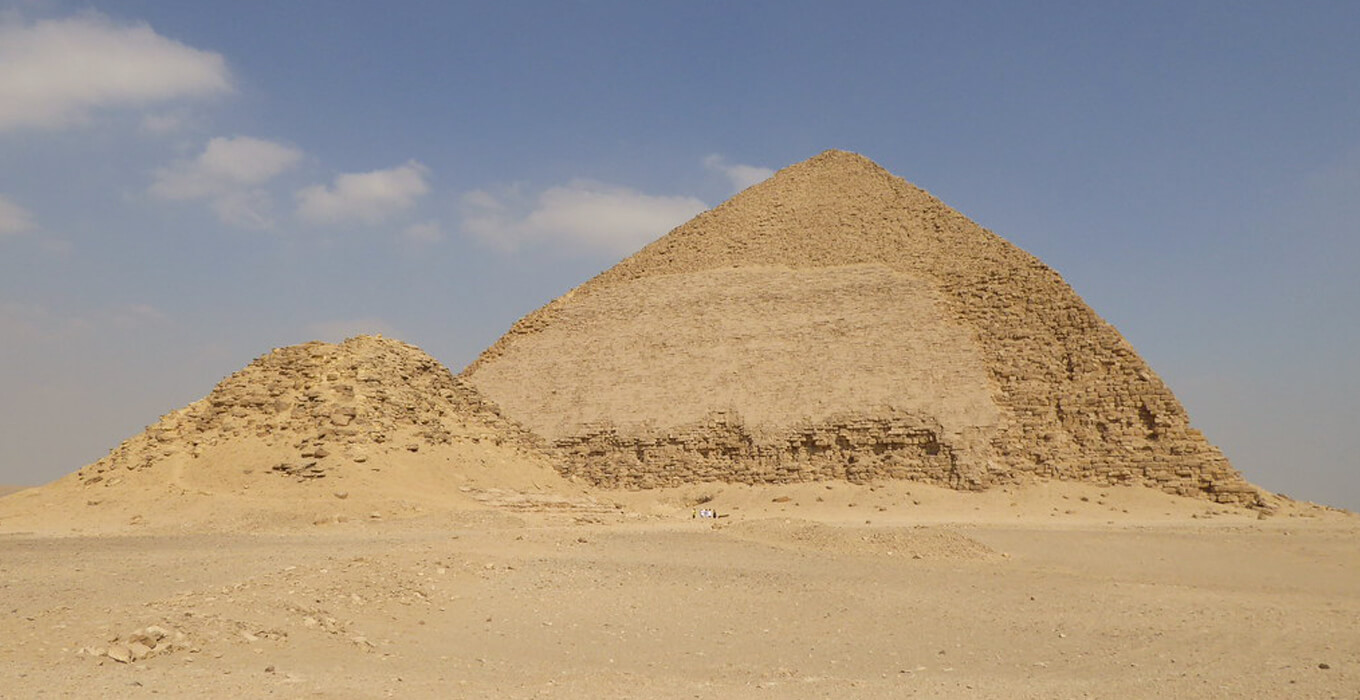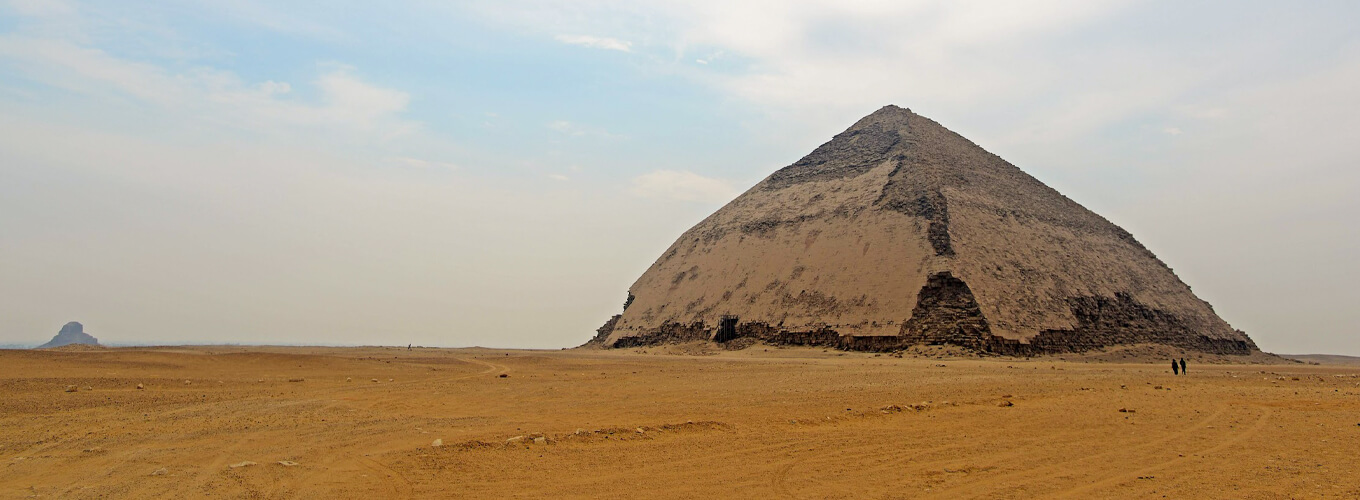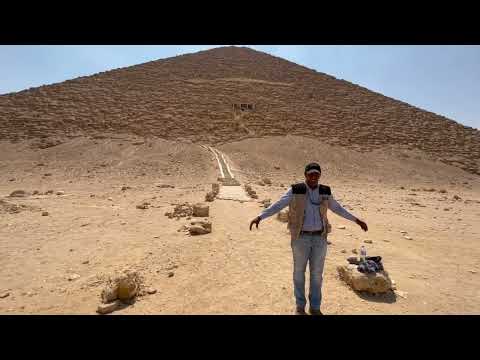What secrets are hidden in the ancient Dahshur Necropolis? This place is not as famous as others but is key to understanding how pyramids were made. It’s near Cairo, about 40 kilometers south.
It tells the story of the Bent and Red Pyramids. These were built when Pharaoh Sneferu was in charge. He was the dad of Khufu, who built the Great Pyramid.
Key Takeaways
- The Dahshur necropolis is an ancient royal burial ground dating back to the Old Kingdom, between 2613-2589 BC.
- Dahshur is home to some of Egypt’s oldest and most well-preserved pyramids, including the renowned Bent and Red Pyramids.
- These pyramids were commissioned by Pharaoh Sneferu, the founder of the 4th Dynasty, and provide insights into the architectural innovations that paved the way for the Giza Pyramids.
- Dahshur Necropolis offers a unique glimpse into the history and evolution of ancient Egyptian pyramid construction.
- Exploring Dahshur with a local guide is recommended to maximize the experience and learn about this lesser-known archaeological treasure.
Introduction to the Dahshur Necropolis
Location and Significance
The Dahshur necropolis is an ancient royal burial site. It’s about 40 kilometers (25 miles) southwest of Cairo, by the Nile River’s west bank. Pharaohs and their families used it from around 2613 BC to 1650 BC.
This necropolis is part of the Memphis necropolis. It also includes the famous Giza Plateau and the Saqqara site.
The Dahshur pyramids, like the Bent and Red Pyramids, are early “true” pyramids. They show a big step in ancient Egyptian architecture. This led to the Giza Pyramids.
The Memphis and its Necropolis has over thirty-eight pyramids. The Great Pyramid of Khufu is the tallest, standing at 146 meters. It’s the only ancient wonder still standing.
The Dahshur necropolis has many archaeological sites. It has over nine thousand rock-cut tombs from different times. These go from the First to the Thirtieth Dynasty, and even to the Graeco-Roman Period.
This place keeps almost 80% of its ancient look and feel. It has pyramids, tombs, and settlements that are very real.
The Bent Pyramid
The Bent Pyramid, also known as the Rhomboidal Pyramid, is an ancient wonder in Egypt. It was built by Pharaoh Sneferu, the 4th Dynasty’s founder. This pyramid shows how ancient design and building skills were changing.
It was made between 2613-2589 BC. The pyramid’s unique shape stands out. At first, it had a steep angle of about 54 degrees. But, the builders changed it to 43.9 degrees for the top, making it two-angled.
Some think the transition pyramid design was on purpose. It might show the creation mound and the joining of Upper and Lower Egypt. Despite the building issues, the Bent Pyramid is well kept. Its limestone casing shines in the sun.
|
Characteristic |
Measurement |
|
Coordinates |
29°47’25″N 31°12’33″E |
|
Total Height |
104.71 meters (344 feet) |
|
Base Length |
189.43 meters (621 feet) at the base, 123.58 meters (405 feet) at the bend |
|
Volume |
1,237,040 cubic meters (43,685,655 cubic feet) |
|
Slope |
54°27’44” below the bend, 43°22′ above the bend |
The Bent Pyramid is a key example of ancient Egyptian architecture’s evolution. Its unique pyramid design shows the builders’ creativity. It’s a favorite spot for visitors to the Dahshur necropolis, showing off the 4th Dynasty’s tech and art skills.

Dahshur Necropolis
The Dahshur necropolis is a UNESCO World Heritage Site in Egypt’s Giza Governorate. It shows the amazing skills of ancient Egyptian royalty in building. The site dates back to the Old and Middle Kingdom periods, from 2613–2589 BC.
It has many famous pyramids like the Bent Pyramid and the Red Pyramid. There are also structures from the 13th Dynasty.
At Dahshur, archaeologists found ruins of seven pyramids and many tombs. These were for queens, princesses, and high-ranking officials. The site gives us a peek into how ancient Egyptian elites lived and died.
The Red Pyramid is a key site here. King Sneferu built it and it’s 341 feet tall with a 43-degree angle. It was the first true pyramid and changed pyramid building forever.
It was built before the Great Pyramid of Giza, which is even taller and steeper. The Red Pyramid’s design influenced later pyramids.
|
Pyramid |
Height (feet) |
Angle (degrees) |
|
Red Pyramid |
341 |
43 |
|
Great Pyramid of Giza |
481 |
52 |
The necropolis also has the White Pyramid and the Black Pyramid. These show how pyramid building changed over time. Nearby, archaeologists found royal women’s tombs with beautiful metalwork.
Dahshur is near Giza and Cairo, making it a key spot for history lovers. It has a hot desert climate but is well looked after. This lets visitors and researchers see the Dahshur necropolis, Old Kingdom pyramids, and Middle Kingdom pyramids.
The Red Pyramid
The Red Pyramid, also known as the Northern Pyramid, was built by Pharaoh Sneferu. He was the father of Khufu (Cheops). It was finished around 2575 BCE. This pyramid was a big step in pyramid design, being the first smooth-sided “true” pyramid.
The pyramid got its name from its red limestone casing. It was once fully covered in red limestone. It stands 105 meters (344 feet) tall and has a base of 220 meters (722 feet). This makes it a masterpiece of architecture, showing Sneferu’s ambition and his architects’ skills.
Sneferu’s Legacy
Sneferu worked hard to improve pyramid building and rebuilt after the Bent Pyramid failed. This shows his ambition and his architects’ skills. The Red Pyramid helped set the stage for the Giza Pyramids built by his son, Khufu. This made Sneferu a visionary pharaoh who changed pyramid design in ancient Egypt.
|
Pyramid Characteristic |
Measurement |
|
Coordinates |
29°48′30″N 31°12′21″E |
|
Height |
105 meters (344 feet) |
|
Base |
220 meters (722 feet) |
|
Volume |
1,694,000 cubic meters (2,216,000 cubic yards) |
|
Slope |
43°22′ |
|
Construction Period |
2575–2563 BCE |
|
Estimated Construction Time |
10–17 years |
The pyramid has a pink granite sarcophagus and a corbelled roof in its burial chamber. It also has two more chambers with similar designs. The entrance is 3 feet high and 4 feet wide, leading to a 40-foot high first chamber.
“The Red Pyramid is one of the most important pyramids in Egypt, offering insights into ancient Egyptian civilization and architectural achievements.”
12th Dynasty Pyramids
The Dahshur necropolis became key again in the 12th Dynasty of the Middle Kingdom (1985-1773 BC). Pharaohs like Amenemhat I, Amenemhat II, Sesostris III, and Amenemhat III built their pyramids there. These pyramids were not as big as the Old Kingdom ones. Yet, they show the skill and care of the Middle Kingdom.
Amenemhat II‘s “White Pyramid” was once bright white. Sesostris III‘s pyramid had a big granite chamber. Dahshur kept being a royal burial place, showing its lasting importance in ancient Egypt.
|
Pharaoh |
Reign |
Pyramid |
Architectural Features |
|
Amenemhat I |
1985 – 1956 BC |
Unidentified |
– |
|
Amenemhat II |
1929 – 1895 BC |
White Pyramid |
Covered in white limestone |
|
Sesostris III |
1878 – 1839 BC |
Pyramid |
Granite burial chamber |
|
Amenemhat III |
1860 – 1814 BC |
Unidentified |
– |
The 12th Dynasty pyramids at Dahshur were not as huge as before. But they show the site’s ongoing role as a royal burial place in ancient Egypt.
Exploring the Dahshur Necropolis
Visitor Information
The Dahshur necropolis is a key spot for learning about ancient Egyptian pyramids. It’s about 30 km south of Cairo. Here, you can see the Bent Pyramid and the Red Pyramid up close. These pyramids, along with 12th Dynasty tombs and big tomb complexes, show Egypt’s rich history.
It’s a good idea to get a local guide to help you. They know a lot about the site’s history and importance. Dahshur is near Giza Plateau and Saqqara. Many tours offer day trips or longer packages to these amazing places.
The necropolis is huge, covering 6 x 2.5 km. You’ll need a few hours to see all the pyramids, tombs, and archaeological sites. The cost to get in is 60 EGP (about $3.50 USD). It’s open every day from 8 AM to 5 PM.
If you love history, architecture, or just want to experience something new, Dahshur is perfect. You’ll see how pyramid design changed over time. You’ll be amazed by the ancient Egyptian builders’ skills. And you’ll understand why this place is so important to history.
Significance of the Site
The Dahshur necropolis is a key part of ancient Egypt’s history. It shows the amazing skills of the pharaohs and their builders. Located 40 kilometers south of Cairo, it has a long history from the Old Kingdom to the Middle Kingdom.
The site is famous for its Bent Pyramid and Red Pyramid. King Sneferu built them in the 4th Dynasty, around 2600 BC. These pyramids mark a big change in pyramid design. They led to the building of the famous Giza Pyramids.
There are many other pyramids and tombs at Dahshur from the Old and Middle Kingdoms. This shows it was a key place for royal burials in Egypt. Archaeologists have found many important things here. These include the remains of royals and high officials.
This tells us a lot about how the ancient Egyptians lived, their social structure, and their beliefs. The Dahshur necropolis is a reminder of Egypt’s ancient greatness. It still fascinates people today, showing us the amazing history of the pharaohs.
Conclusion
The Dahshur necropolis is a key site in ancient Egyptian history. It shows how architecture and culture changed over time. The Bent and Red Pyramids highlight the pharaohs’ creativity and big dreams.
Sneferu’s pyramids at Dahshur were crucial for the Giza Pyramids. They set the stage for Egypt’s famous pyramids.
Dahshur kept being a royal burial place during the Middle Kingdom. This shows its lasting importance in ancient Egyptian culture. Today, it lets visitors see the pharaohs’ great work and learn about ancient Egypt’s history.
Efforts to preserve Dahshur are ongoing, thanks to UNESCO. This makes it even more important as an ancient Egyptian site. By visiting, travelers can dive into Dahshur’s story. They’ll see the lasting impact of Egypt’s ancient people.
Read our related articles:


